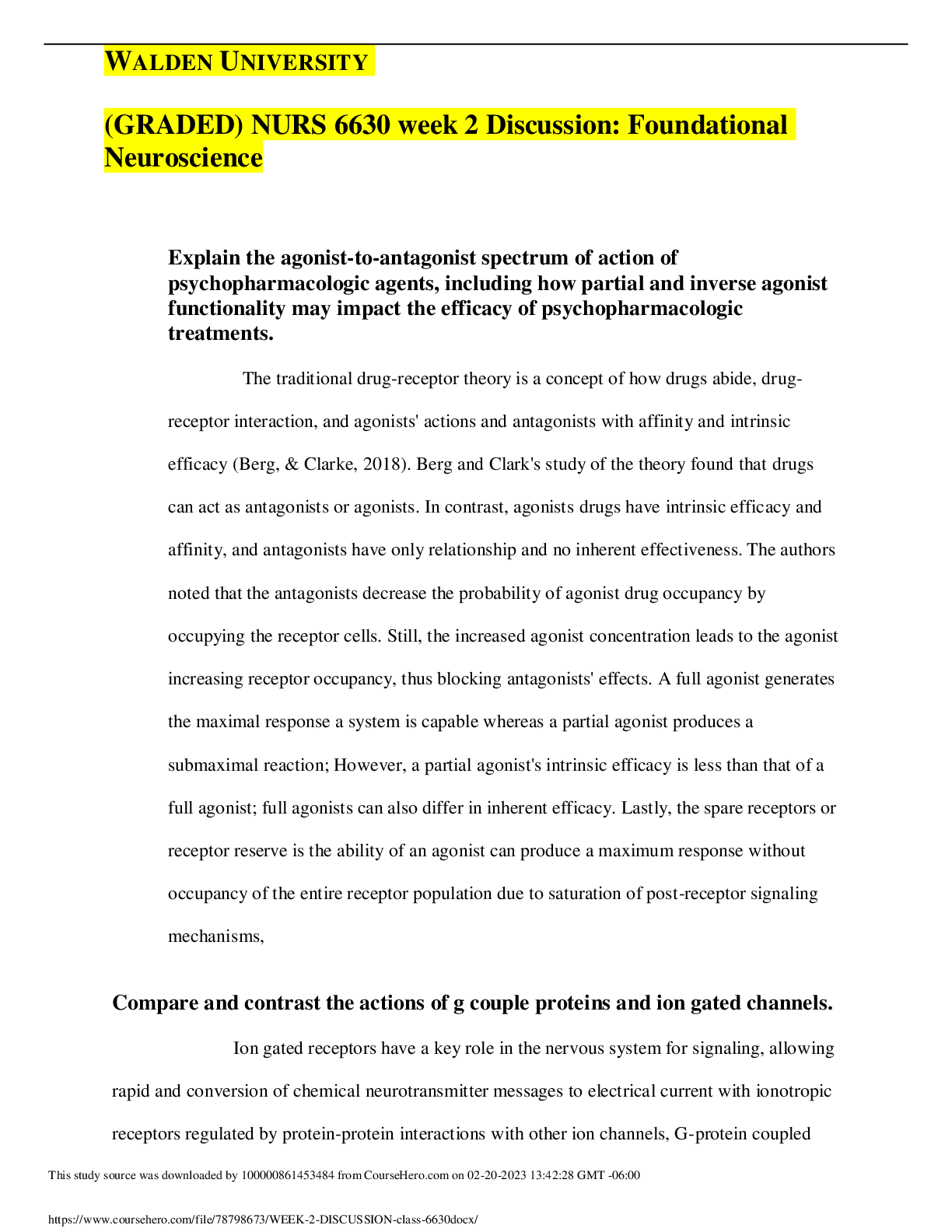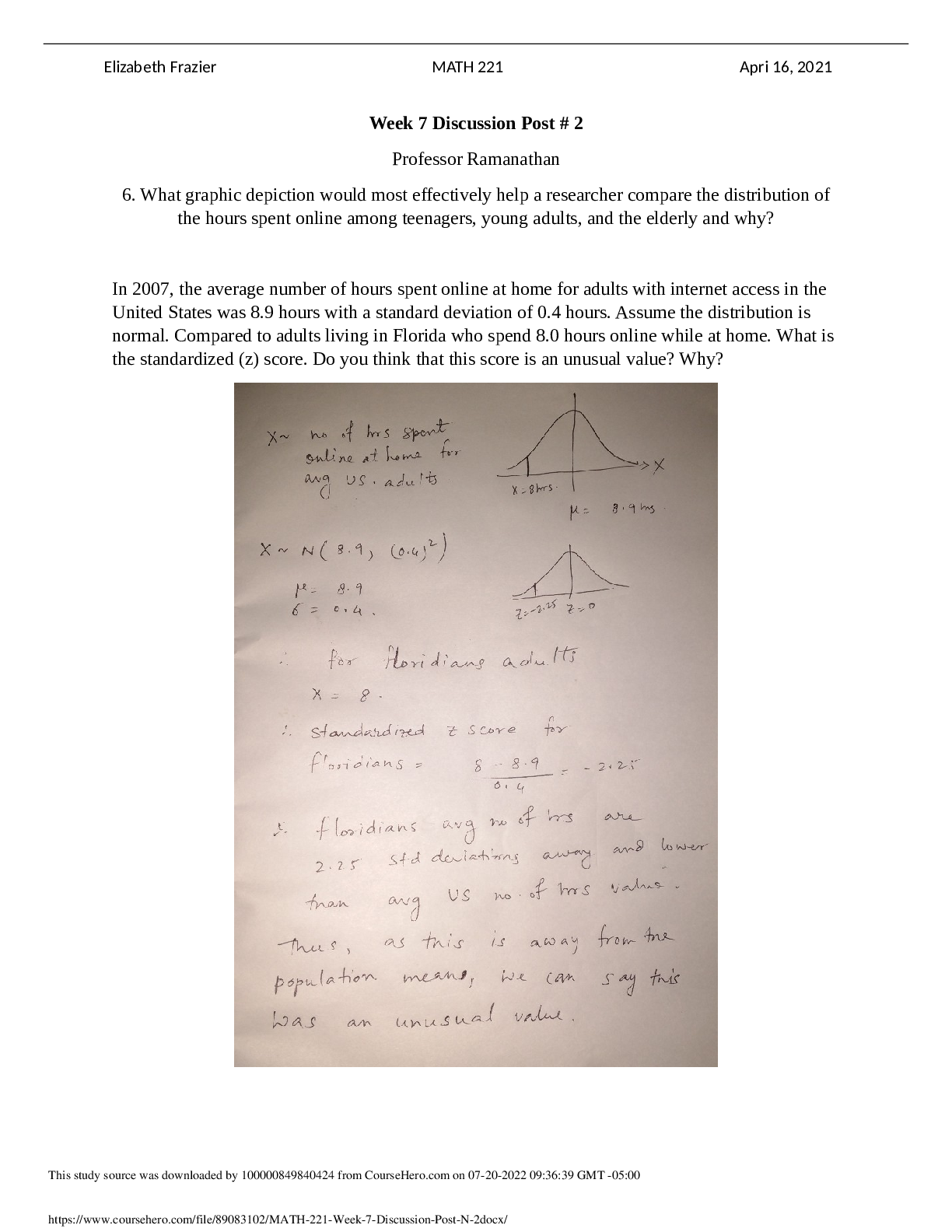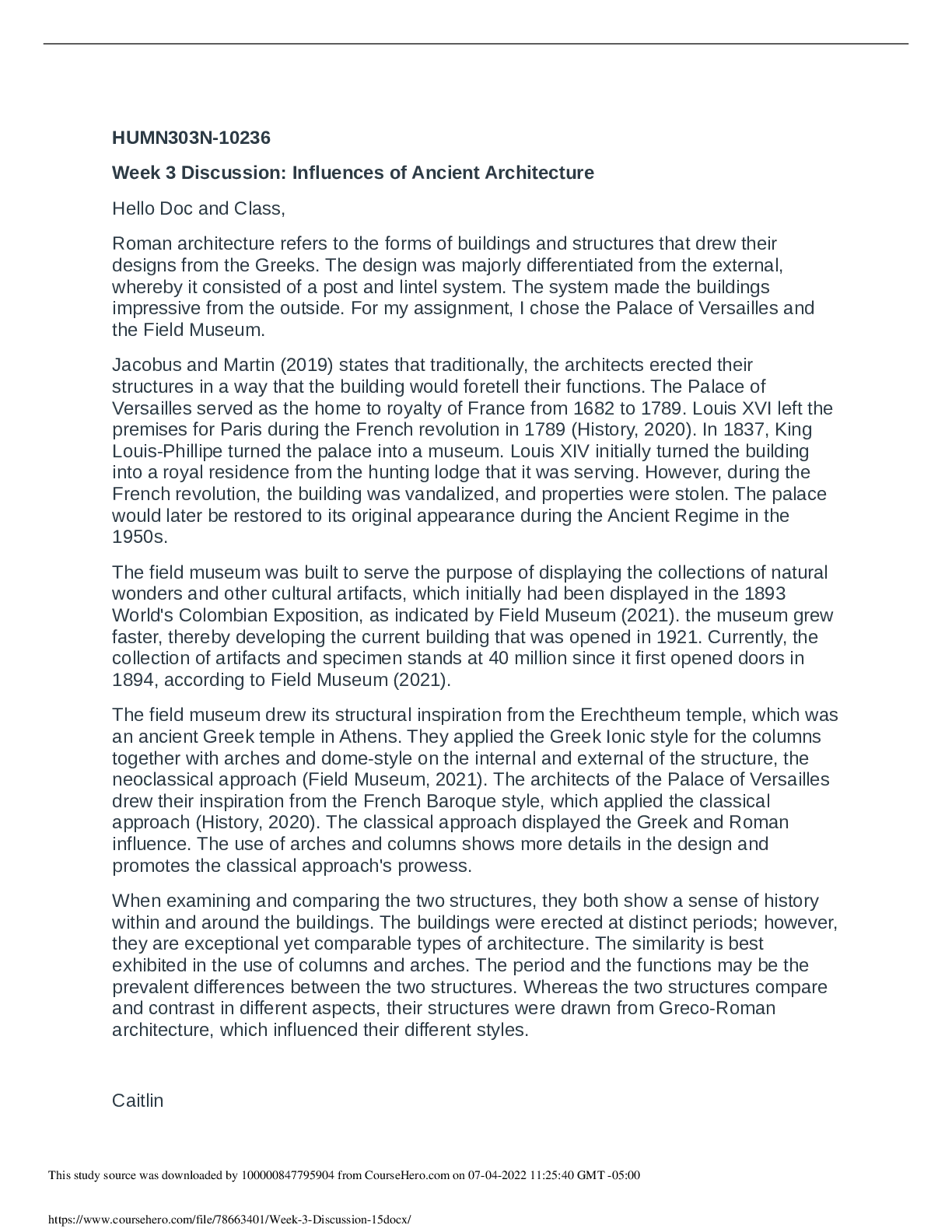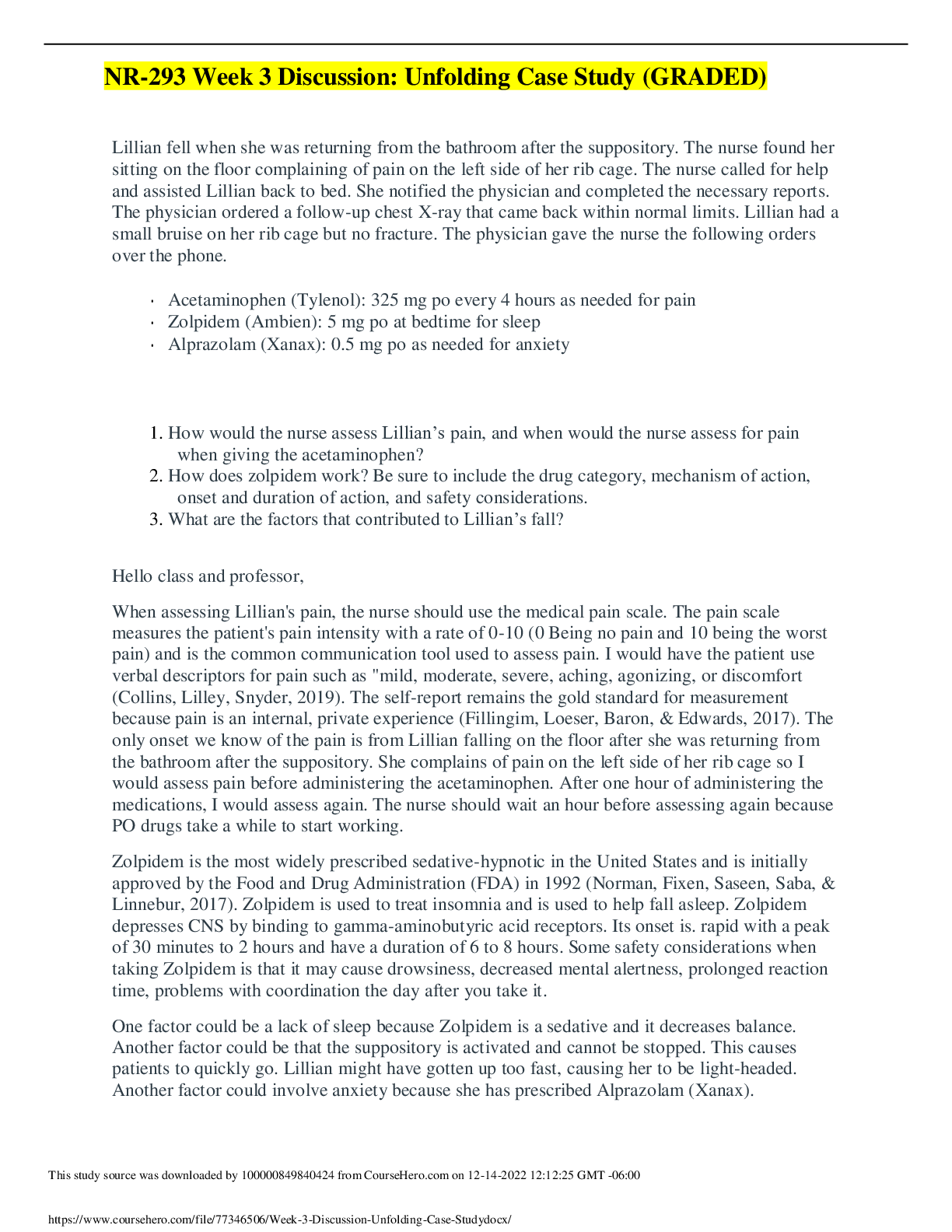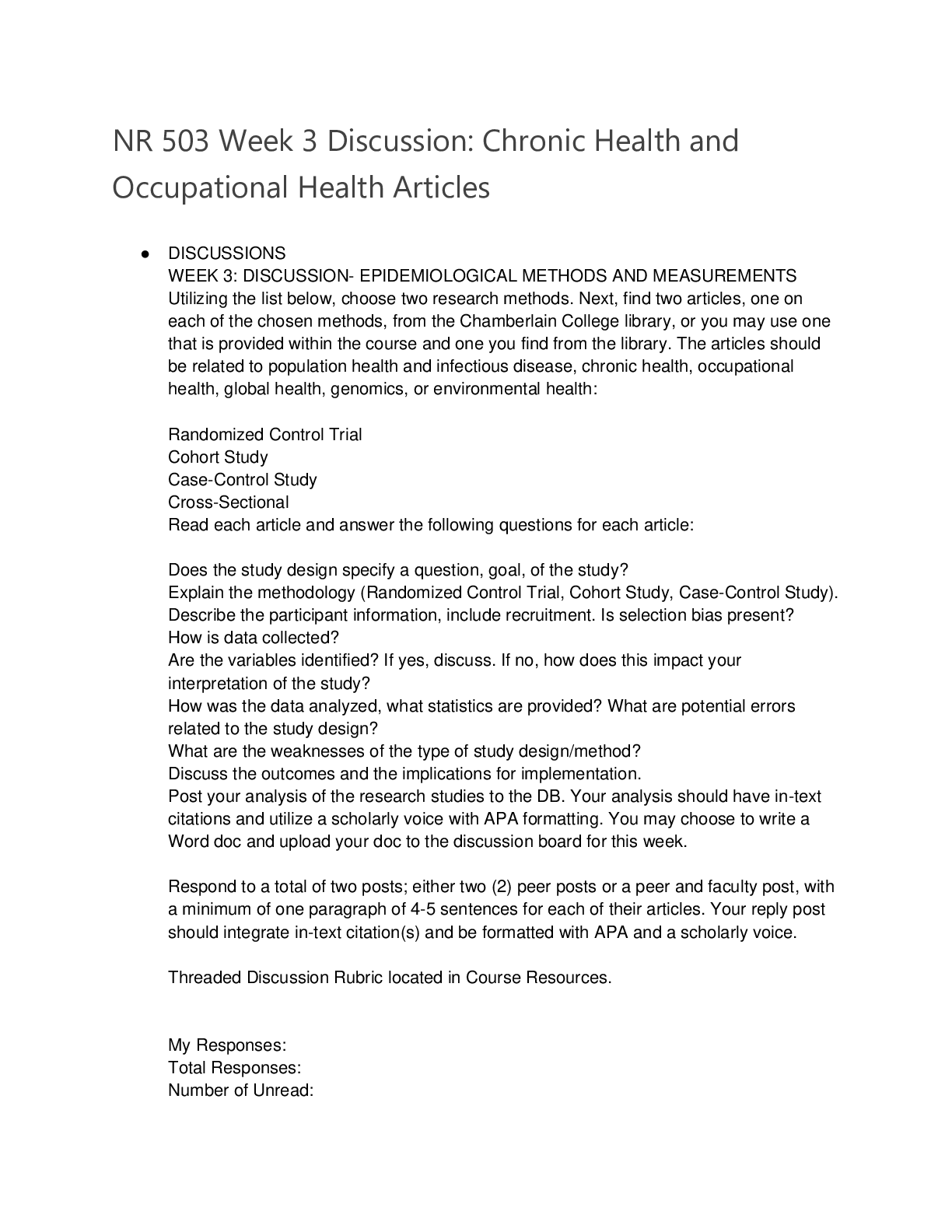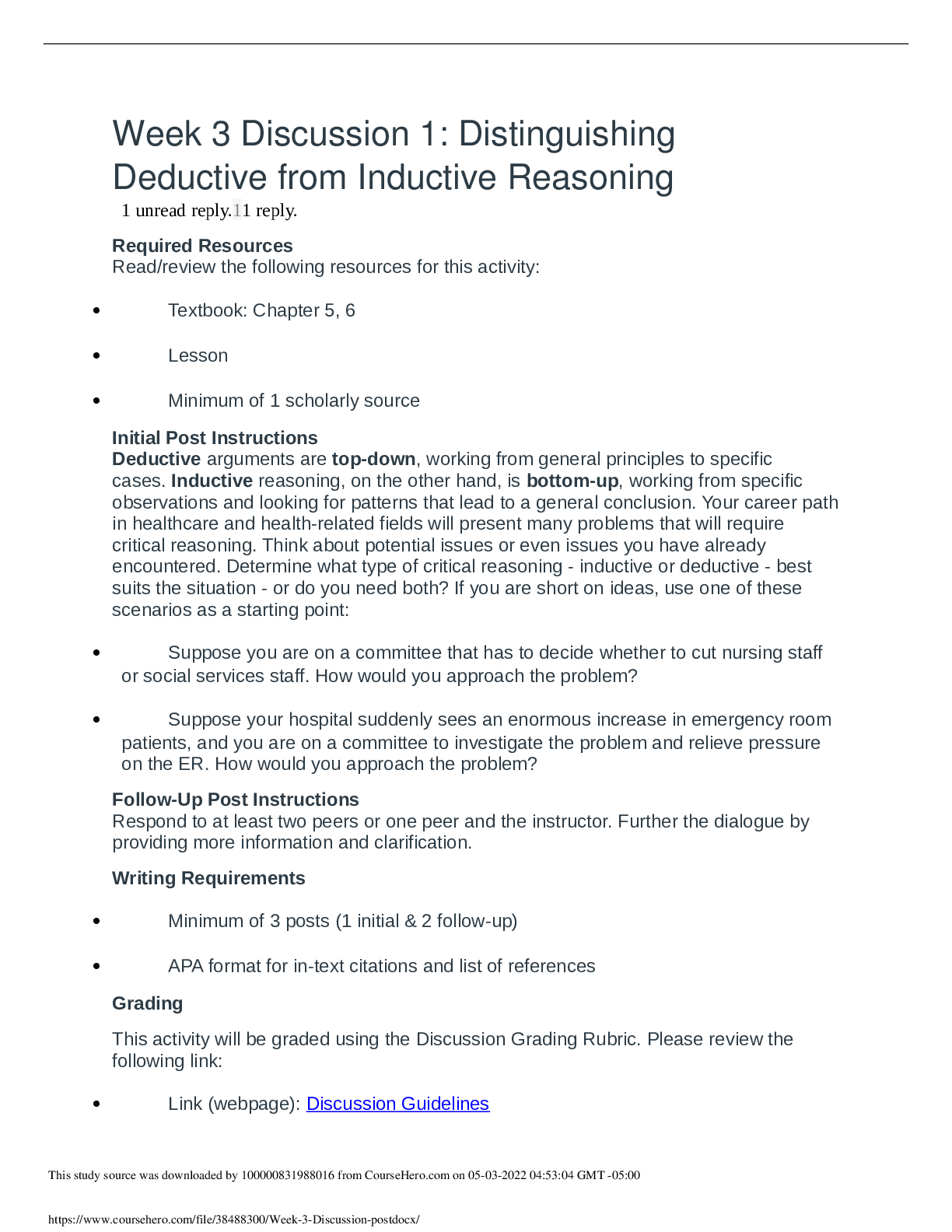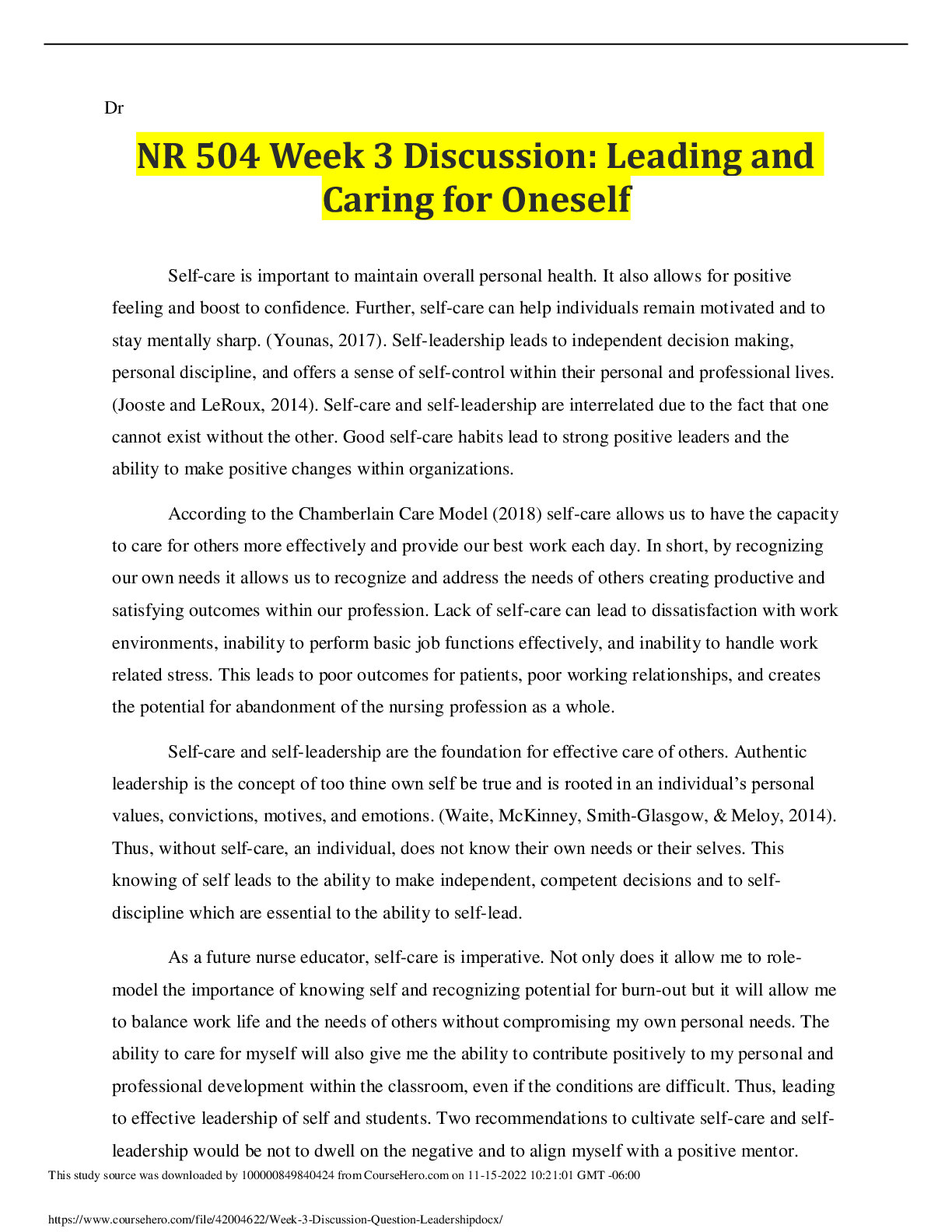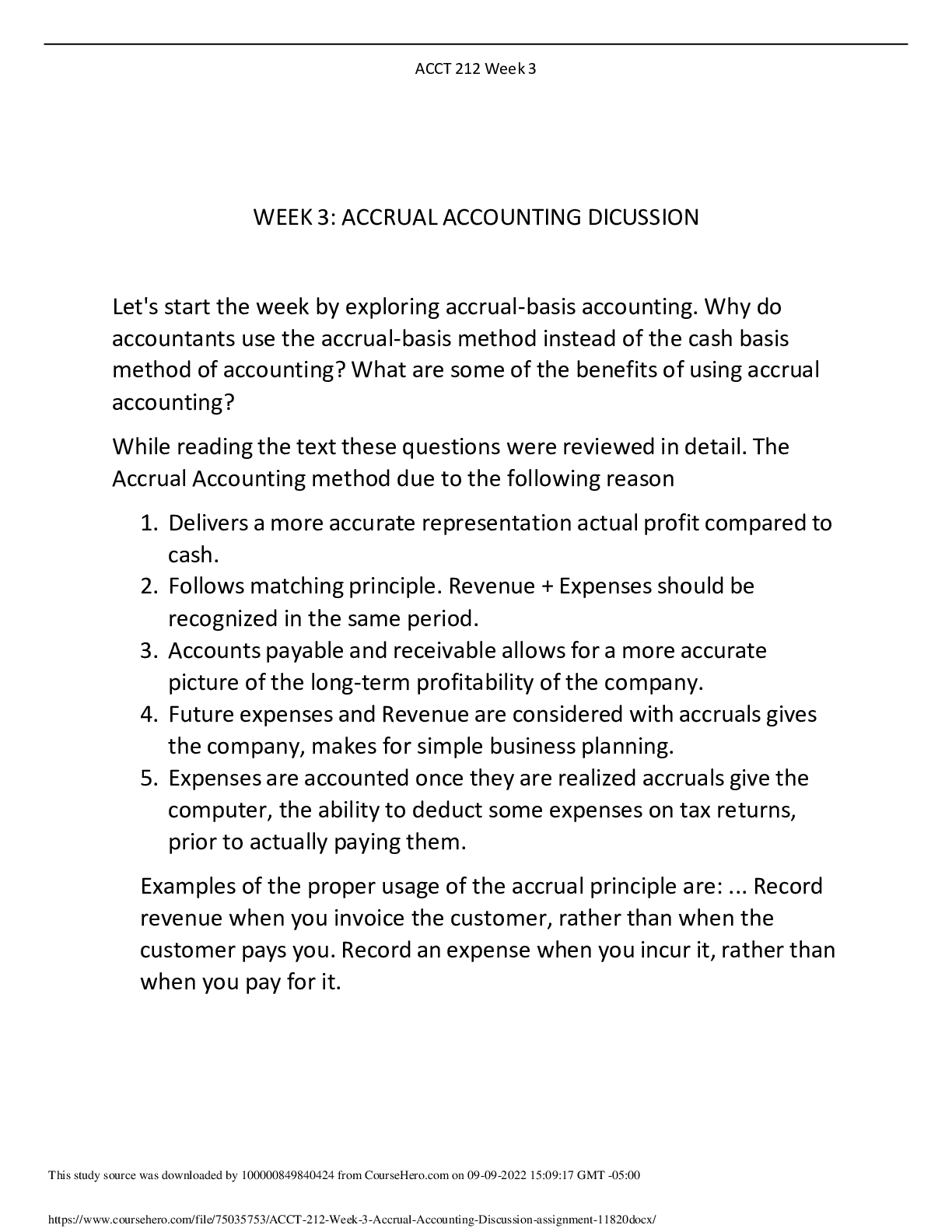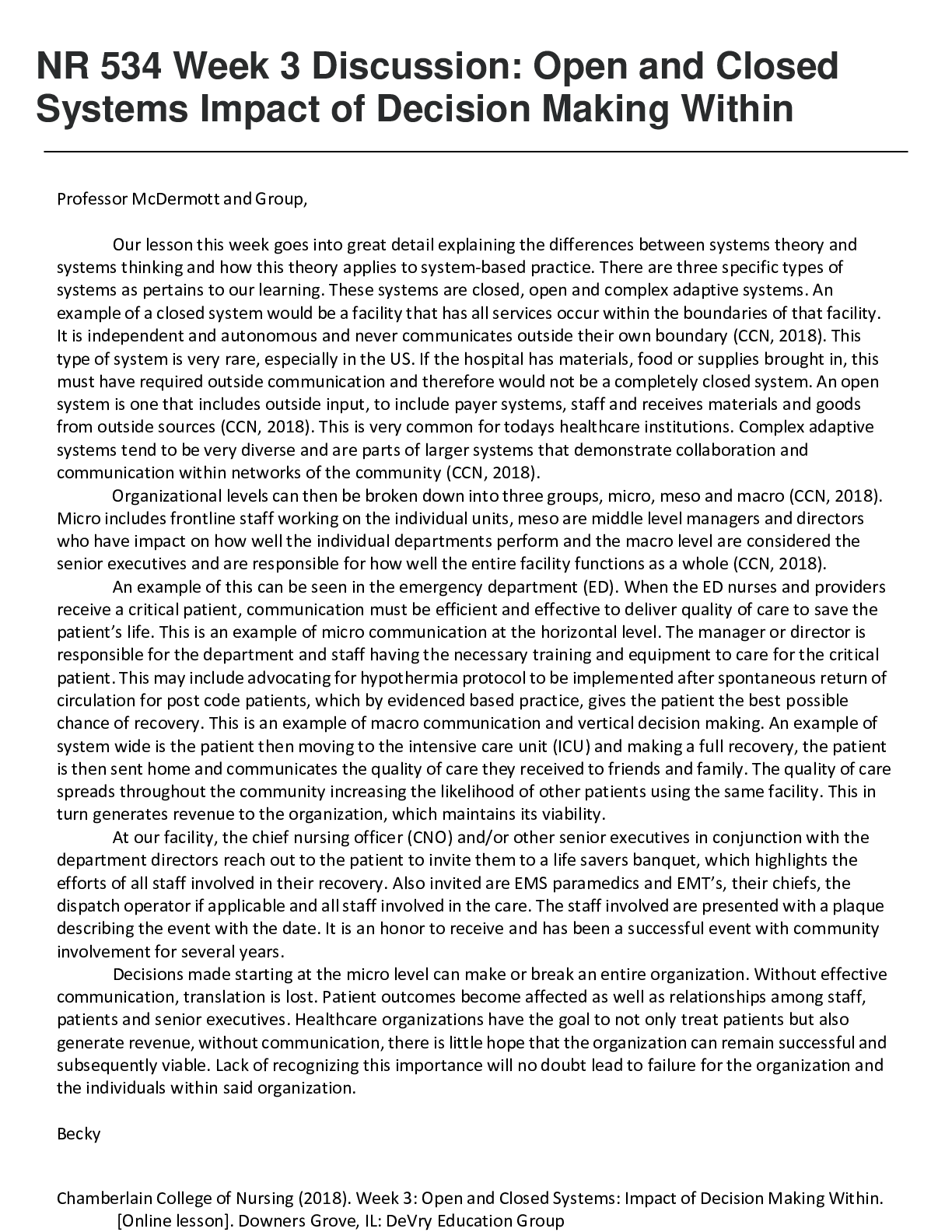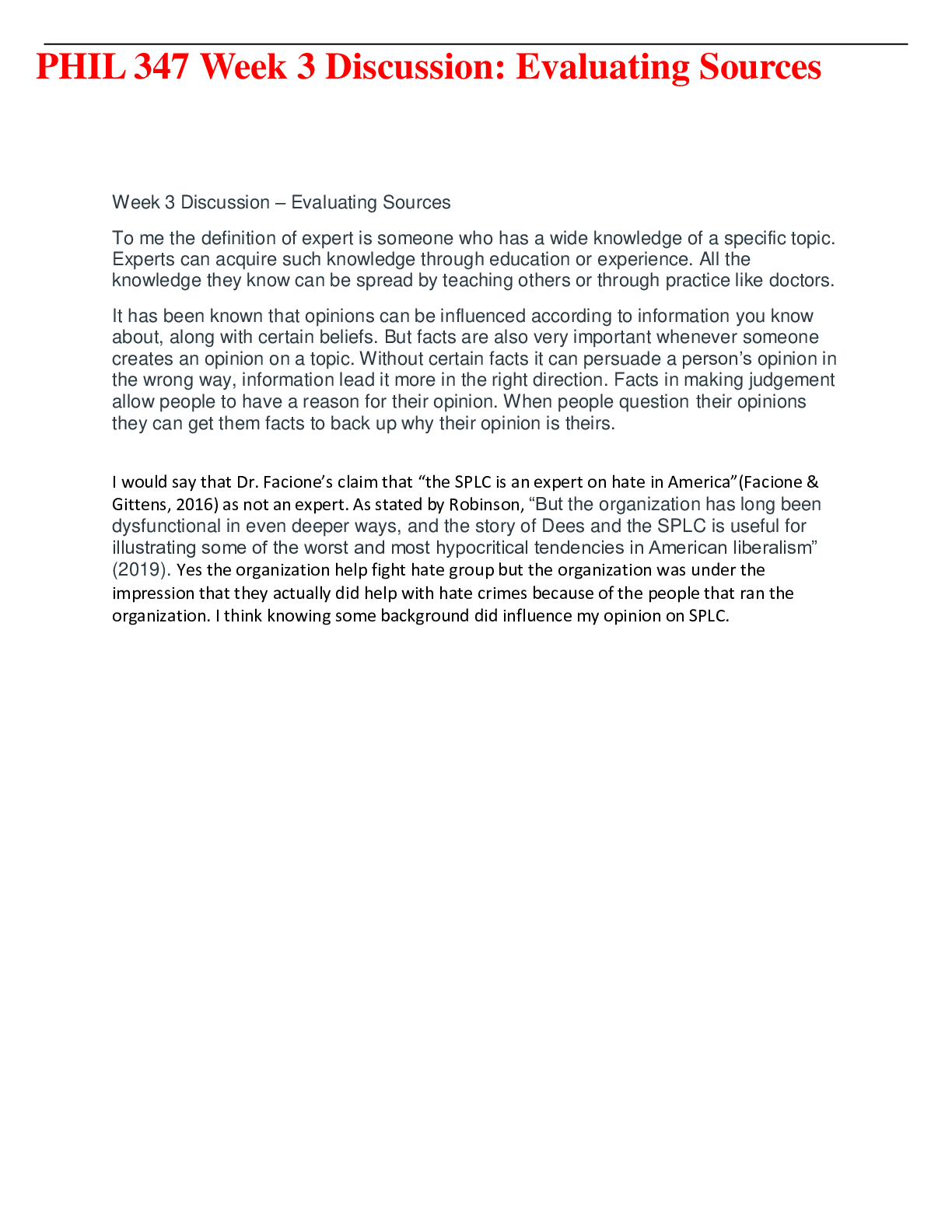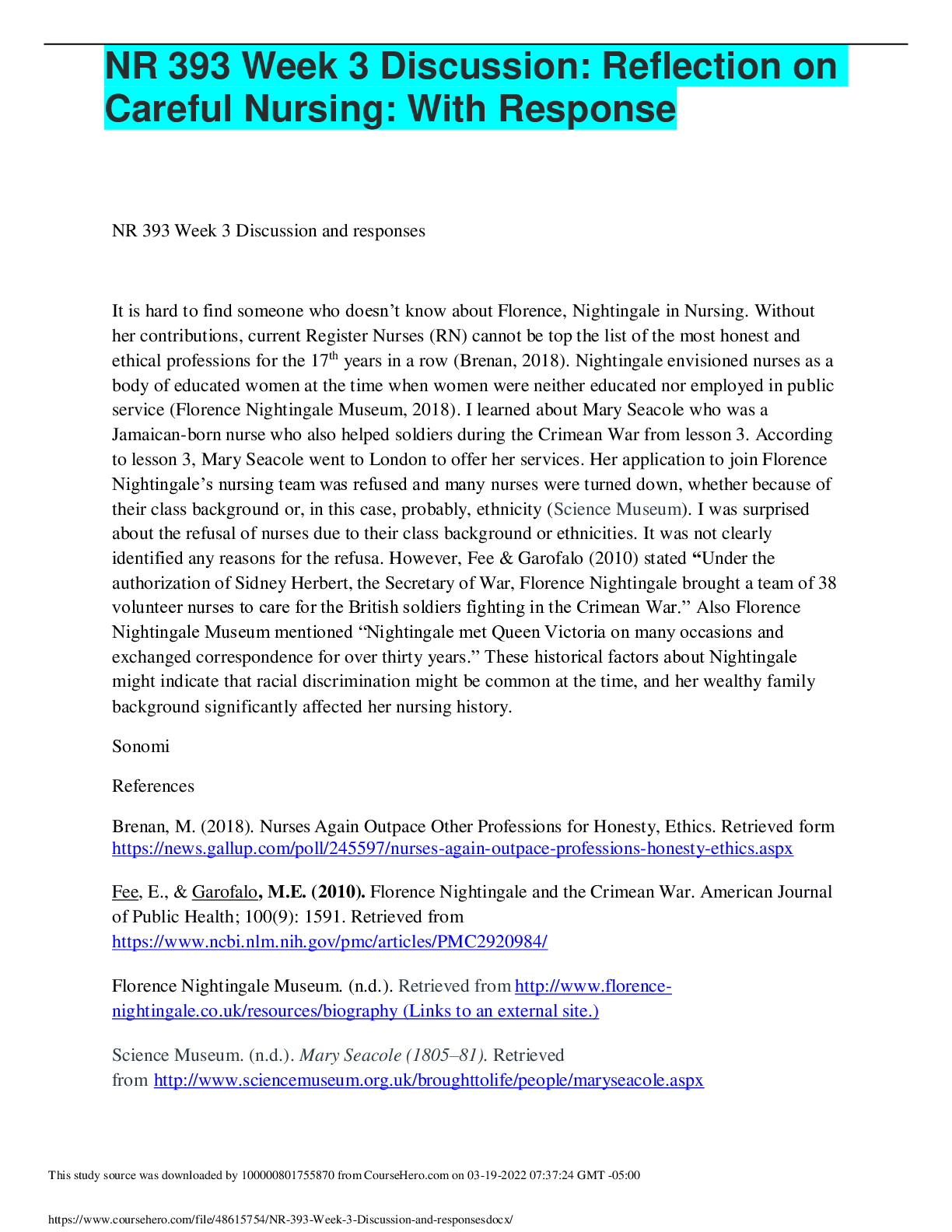*NURSING > DISCUSSION POST > NR 503 Week 3 Discussion: Epidemiological Methods and Measurements – Compare and Contrast the Coho (All)
NR 503 Week 3 Discussion: Epidemiological Methods and Measurements – Compare and Contrast the Cohort Method with the Randomized Controlled Trial
Document Content and Description Below
NR 503 Week 3 Discussion: Epidemiological Methods and Measurements – Compare and Contrast the Cohort Method with the Randomized Controlled Trial 1. What is the fundamental difference between ... the method you have chosen (either the case-control or cohort method) and the randomized controlled trial? 2. What are the advantages and disadvantages of the study method you chose (case-control or cohort study)? 3. What are the characteristics of a correlational study? 4. Where does the method you chose (case-control or cohort study) fall on the research pyramid? What does where it is on the research pyramid mean ello Dr. Jones and Class, This week I have chosen to compare and contrast the cohort study method against the randomized controlled trial (RCT) study method, describe the advantages and disadvantages of the cohort study method, explain the characteristics of a correlation study, and state where the cohort study method falls on the research pyramid and what that means. The epidemiological cohort study method has advantages and disadvantages. While labor-intensive, costly, and done over a prolonged period of time, the cohort study method can be done either prospective or retrospectively (Curly Cupp, 2020). Comparatively, RCT disadvantages are also that they are labor-intensive, costly, and lengthy but an advantage is that RCTs are able to provide very reliable scientific evidence (Curly Cupp, 2020). In contrast, a cohort study method design is easier to implement and study multiple outcomes versus an RCT which requires stricter adherence to guidelines (Curly Cupp, 2020). What is the fundamental difference between the method you have chosen and the randomized controlled trial? Obesity is a chronic disease that I have been focusing on throughout this course. Rush et al. (2016) cohort study objective is to assess obesity in U.S. service members and veterans; specifically, prevalence and health outcomes associated with obesity. Millennium Cohort Study includes voluntary members from all service branches of the U.S. military (Rush et al., 2016). Previous studies using the Millennium Cohort acknowledged that military personal close to being discharged gained weight and preventative measures were needed to be implemented during this critical timeframe (Rush et al., 2016). A probability-based sample of the whole military population was apart of the first panel with a focus on sample participants being obtained from specific subgroups that fit the criteria (Rush et al., 2016). This study, unlike RCTs, which are prospective, is retrospective and the sample population in RCT is randomly assigned to a group unlike in this study where the sample population was randomly selected but pulled primarily from a specific subgroup (Curly Cupp, 2020; Rush et al., 2016). The body mass index (BMI) screening tool was used and the data for this screening tool was obtained through self-reported height and body weight measurements (Rush et al., 2016). The same study population was used, excluding those that did not succinctly report data, in order to accurately analyze BMI changes over time; a baseline evaluation and two additional visits occurred to assess for changes (Rush et al., 2016). This study found that active and veteran service members have consistently over time been susceptible to weight gain and obesity affecting both male and females alike with the continued upward progression of obesity rates of 25% to 34% for male veterans, with a timeframe from 2004 to 2006, and 19% to 26% for female veterans with a timeframe from 2007 to 2008 (Rush et al., 2016). As stated previously, an attribute of the cohort study method is that it can be done prospectively and retrospectively (Curly Cupp, 2020). This study suggests that additional cohort studies that examine causes of overweight and obesity that follow a sample of service- members and veterans over time longitudinally by monitoring their body weight are needed (Rush et al., 2016). This cohort study area of interest can continue to be studied following the same cohort population prospectively monitoring those that have developed comorbidities (Rush et al., 2016). Hutchesson et al. (2020) study correlates cohort studies regarding women of childbearing age in the prevention and treatment of overweight and obesity with the method of the study focus being RCTs. The RCTs or systematic reviews of RCTs analyzed by this study were obtained using an electronic database with precise inclusion and exclusion criteria with a specific timeframe (Hutchesson et al., 2020). Compared to a cohort study where sample population criteria are not as precise, for example, the cohort study by Rush et al. (2016) whose sample participants were obtained from over-sampling subgroups that fit the criteria (Curly Cupp, 2020). RCTs and systematic reviews of RCTs have been found to be the two best levels of evidence for intervention evaluation (Hutchesson et al., 2020). The benefit of this particular study’s review of 87 RCTs and three systematic reviews of RCTs, found that there is an increased interest in studies focusing on women of childbearing age and the support that is needed to prevent and treat overweight and obesity in this cohort (Hutchesson et al., 2020) Ninety percent of the RCT studies support pregnant women and post-partum women to be an appropriate weight (Hutchesson et al., 2020). This finding is supportive of the aim of an RCT which is to evaluate treatments and interventions, in this study's case supporting women of childbearing age in the prevention and treatment of overweight and obesity, in an effort to provide better patient outcomes (Curly Cupp, 2020; Hutchesson et al., 2020). What are the advantages and disadvantages of the study method you chose This ability to see results longitudinally is an advantage of cohort studies that as a future Family Nurse Practitioner I can appreciate implementing the evidence-based findings into primary prevention with future patients. As previously stated, a cohort study method’s disadvantage is that they are labor intense, costly, and done over a prolonged period of time (Curly Cupp, 2020). Therefore, the question remains, do the advantages outweigh the disadvantages of a cohort study method? What are the characteristics of a correlational study? Correlation studies evaluate whether or not there are similarities between two variables such as aggregates or populations (Curly Cupp, 2020; Hain, 2017). Cooksey- Stowers et al. (2017) performed a correlation study regarding food swamps, high- density of businesses in a location/area that sells low nutritional value foods, having a statistically positive effect on adult obesity. This correlation study’s aim was to provide evidence-based data to local governments to promote food retailers that sell healthier foods to locate to food swamp locations (Cooksey-Stowers et al., 2017). Correlation studies are beneficial in that they provide a basis for more rigorous studies to be brought to fruition (Curly Cupp, 2020). Where does the method you chose (case-control or cohort study) fall on the research pyramid? What does where it is on the research pyramid mean? Cohort studies are Level 4 (case-control or cohort studies) on the research Evidence Pyramid (Curly Cupp, 2020). Meaning it carries less credibility than Level 1 (systematic reviews and meta-analysis of RCTs), Level 2 (RCTs), and Level 3 (controlled trials) (Curly Cupp, 2020). However, this means that the cohort study method carries more validity than Level 5 (systematic review of descriptive and qualitative studies), Level 6 (single descriptive or qualitative studies), and Level 7 (expert opinion) (Curly Cupp, 2020). St. John and McNeal (2017) identify cohort studies are a key method for determining how helpful, to a broader group of people, the findings of a study might be. Ultimately, the goal of any research is to produce evidence that can be used to promote and support better practice and patient outcomes equitably in healthcare settings and public health settings (Hain, 2017). References: Cooksey-Stowers, K., Schwartz, M.B., & Brownell, K.D. (2017). Food swamps predict obesity rates better than food deserts in the United States. International Journal of Environmental Research and Public Health, 14(11), 1-20. http://doi.org/10.3390/ijerph14111366 Curly Cupp, L. A. (2020). Population-based nursing: Concepts and competencies for advanced practice. (3rd ed.). Springer Publishing Company. Hain, D.J. (2017). Exploring the evidence. Focusing on the fundamentals: Comparing and contrasting nursing research and quality improvement. Nephrology Nursing Journal, 44(6), 541-544. ello Dr. Jones and Class, This week I have chosen to compare and contrast the cohort study method against the randomized controlled trial (RCT) study method, describe the advantages and disadvantages of the cohort study method, explain the characteristics of a correlation study, and state where the cohort study method falls on the research pyramid and what that means. The epidemiological cohort study method has advantages and disadvantages. While labor-intensive, costly, and done over a prolonged period of time, the cohort study method can be done either prospective or retrospectively (Curly Cupp, 2020). Comparatively, RCT disadvantages are also that they are labor-intensive, costly, and lengthy but an advantage is that RCTs are able to provide very reliable scientific evidence (Curly Cupp, 2020). In contrast, a cohort study method design is easier to implement and study multiple outcomes versus an RCT which requires stricter adherence to guidelines (Curly Cupp, 2020). What is the fundamental difference between the method you have chosen and the randomized controlled trial? Obesity is a chronic disease that I have been focusing on throughout this course. Rush et al. (2016) cohort study objective is to assess obesity in U.S. service members and veterans; specifically, prevalence and health outcomes associated with obesity. Millennium Cohort Study includes voluntary members from all service branches of the U.S. military (Rush et al., 2016). Previous studies using the Millennium Cohort acknowledged that military personal close to being discharged gained weight and preventative measures were needed to be implemented during this critical timeframe (Rush et al., 2016). A probability-based sample of the whole military population was apart of the first panel with a focus on sample participants being obtained from specific subgroups that fit the criteria (Rush et al., 2016). This study, unlike RCTs, which are prospective, is retrospective and the sample population in RCT is randomly assigned to a group unlike in this study where the sample population was randomly selected but pulled primarily from a specific subgroup (Curly Cupp, 2020; Rush et al., 2016). The body mass index (BMI) screening tool was used and the data for this screening tool was obtained through self-reported height and body weight measurements (Rush et al., 2016). The same study population was used, excluding those that did not succinctly report data, in order to accurately analyze BMI changes over time; a baseline evaluation and two additional visits occurred to assess for changes (Rush et al., 2016). This study found that active and veteran service members have consistently over time been susceptible to weight gain and obesity affecting both male and females alike with the continued upward progression of obesity rates of 25% to 34% for male veterans, with a timeframe from 2004 to 2006, and 19% to 26% for female veterans with a timeframe from 2007 to 2008 (Rush et al., 2016). As stated previously, an attribute of the cohort study method is that it can be done prospectively and retrospectively (Curly Cupp, 2020). This study suggests that additional cohort studies that examine causes of overweight and obesity that follow a sample of service- members and veterans over time longitudinally by monitoring their body weight are needed (Rush et al., 2016). This cohort study area of interest can continue to be studied following the same cohort population prospectively monitoring those that have developed comorbidities (Rush et al., 2016). Hutchesson et al. (2020) study correlates cohort studies regarding women of childbearing age in the prevention and treatment of overweight and obesity with the method of the study focus being RCTs. The RCTs or systematic reviews of RCTs analyzed by this study were obtained using an electronic database with precise inclusion and exclusion criteria with a specific timeframe (Hutchesson et al., 2020). Compared to a cohort study where sample population criteria are not as precise, for example, the cohort study by Rush et al. (2016) whose sample participants were obtained from over-sampling subgroups that fit the criteria (Curly Cupp, 2020). RCTs and systematic reviews of RCTs have been found to be the two best levels of evidence for intervention evaluation (Hutchesson et al., 2020). The benefit of this particular study’s review of 87 RCTs and three systematic reviews of RCTs, found that there is an increased interest in studies focusing on women of childbearing age and the support that is needed to prevent and treat overweight and obesity in this cohort (Hutchesson et al., 2020) Ninety percent of the RCT studies support pregnant women and post-partum women to be an appropriate weight (Hutchesson et al., 2020). This finding is supportive of the aim of an RCT which is to evaluate treatments and interventions, in this study's case supporting women of childbearing age in the prevention and treatment of overweight and obesity, in an effort to provide better patient outcomes (Curly Cupp, 2020; Hutchesson et al., 2020). What are the advantages and disadvantages of the study method you chose This ability to see results longitudinally is an advantage of cohort studies that as a future Family Nurse Practitioner I can appreciate implementing the evidence-based findings into primary prevention with future patients. As previously stated, a cohort study method’s disadvantage is that they are labor intense, costly, and done over a prolonged period of time (Curly Cupp, 2020). Therefore, the question remains, do the advantages outweigh the disadvantages of a cohort study method? What are the characteristics of a correlational study? Correlation studies evaluate whether or not there are similarities between two variables such as aggregates or populations (Curly Cupp, 2020; Hain, 2017). Cooksey- Stowers et al. (2017) performed a correlation study regarding food swamps, high- density of businesses in a location/area that sells low nutritional value foods, having a statistically positive effect on adult obesity. This correlation study’s aim was to provide evidence-based data to local governments to promote food retailers that sell healthier foods to locate to food swamp locations (Cooksey-Stowers et al., 2017). Correlation studies are beneficial in that they provide a basis for more rigorous studies to be brought to fruition (Curly Cupp, 2020). Where does the method you chose (case-control or cohort study) fall on the research pyramid? What does where it is on the research pyramid mean? Cohort studies are Level 4 (case-control or cohort studies) on the research Evidence Pyramid (Curly Cupp, 2020). Meaning it carries less credibility than Level 1 (systematic reviews and meta-analysis of RCTs), Level 2 (RCTs), and Level 3 (controlled trials) (Curly Cupp, 2020). However, this means that the cohort study method carries more validity than Level 5 (systematic review of descriptive and qualitative studies), Level 6 (single descriptive or qualitative studies), and Level 7 (expert opinion) (Curly Cupp, 2020). St. John and McNeal (2017) identify cohort studies are a key method for determining how helpful, to a broader group of people, the findings of a study might be. Ultimately, the goal of any research is to produce evidence that can be used to promote and support better practice and patient outcomes equitably in healthcare settings and public health settings (Hain, 2017). References: Cooksey-Stowers, K., Schwartz, M.B., & Brownell, K.D. (2017). Food swamps predict obesity rates better than food deserts in the United States. International Journal of Environmental Research and Public Health, 14(11), 1-20. http://doi.org/10.3390/ijerph14111366 Curly Cupp, L. A. (2020). Population-based nursing: Concepts and competencies for advanced practice. (3rd ed.). Springer Publishing Company. Hain, D.J. (2017). Exploring the evidence. Focusing on the fundamentals: Comparing and contrasting nursing research and quality improvement. Nephrology Nursing Journal, 44(6), 541-544. Hutchesson, M.J., de Jonge Mulock Houwer, M., Brown, H.M., Lim, S., Moran, L.J., Vincze, L., Rollo, M.E., & Hollis, J.L. (2020). Supporting women of childbearing age in the prevention and treatment of overweight and obesity: a scoping review of randomized control trials of behavioral interventions. BMC Women’s Health, 20(1), 1-15. http://doi.org/10.1186/s12905-020-0882-3 Rush, T., LeardMann, C.A., & Crum-Cianflone, N.F. (2016). Obesity and associated adverse health outcomes among US military members and veterans: Findings from the millennium cohort study. Obesity, 24(7), 1582-1589. http://doi.org/10.1002/oby.21513 St. John, K., & McNeal, K.S. (2017). The strength of evidence pyramid: One approach for characterizing the strength of evidence of geoscience education research (GER) community claims. Journal of Geoscience Education, 65(4), 363-372 [Show More]
Last updated: 1 year ago
Preview 1 out of 7 pages
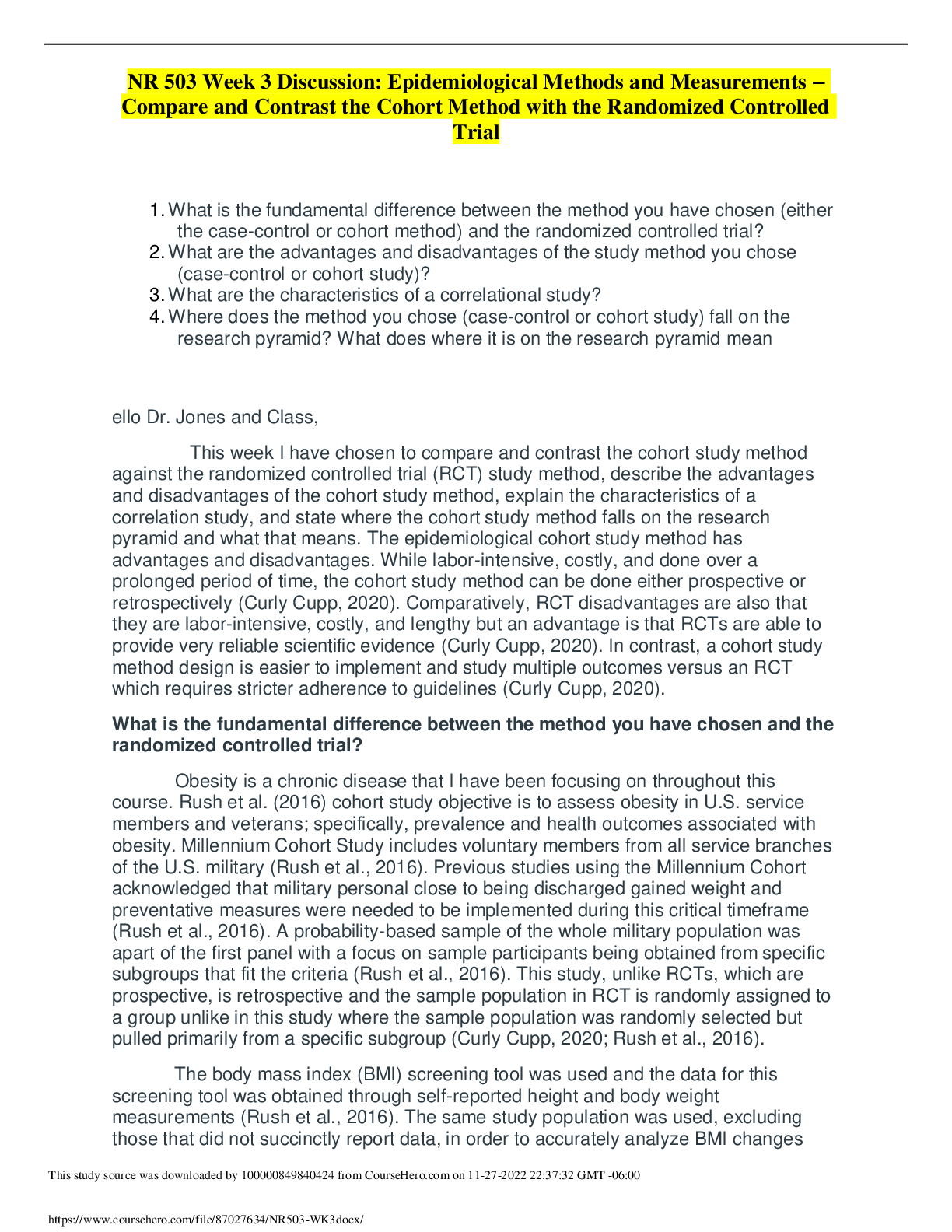
Reviews( 0 )
Document information
Connected school, study & course
About the document
Uploaded On
Nov 28, 2022
Number of pages
7
Written in
Additional information
This document has been written for:
Uploaded
Nov 28, 2022
Downloads
0
Views
49


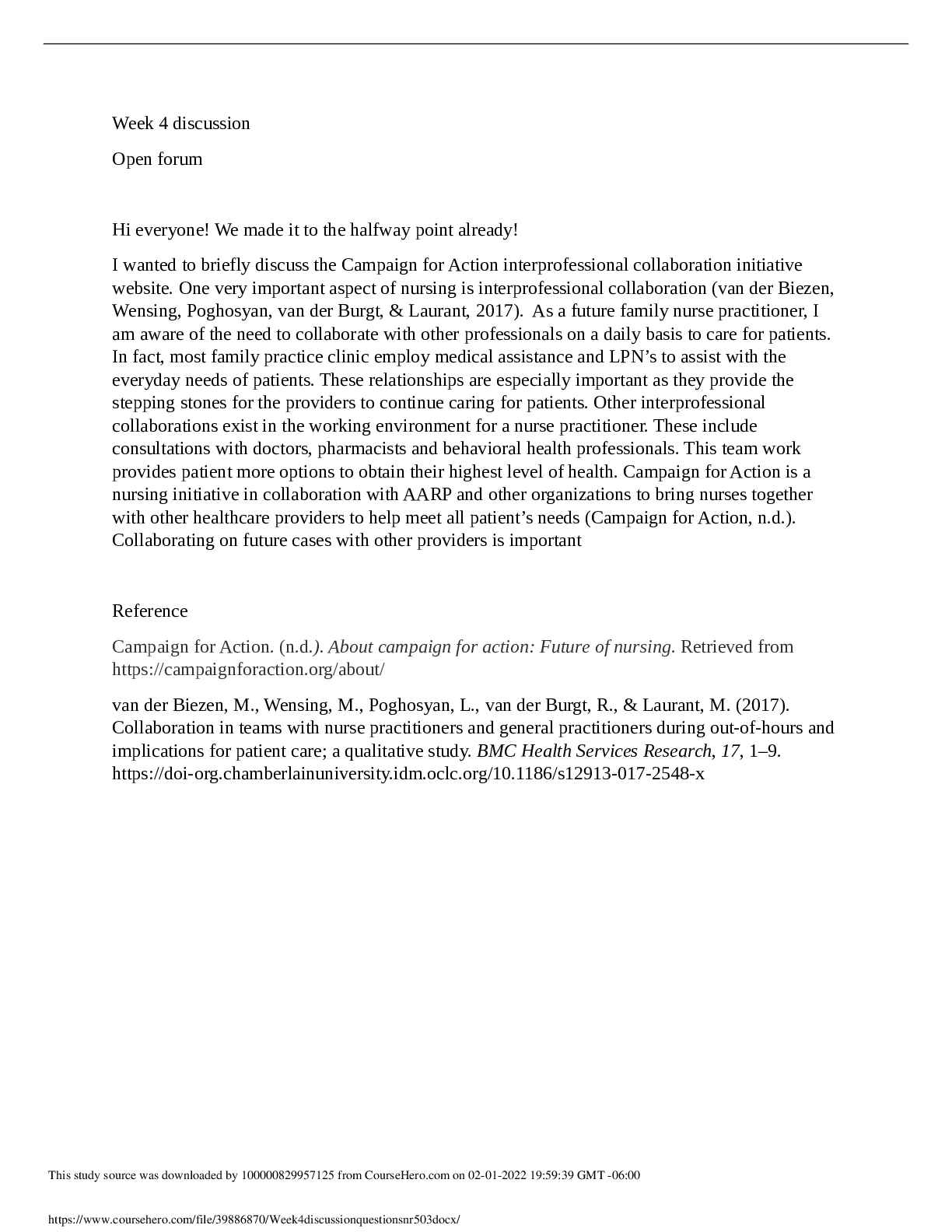

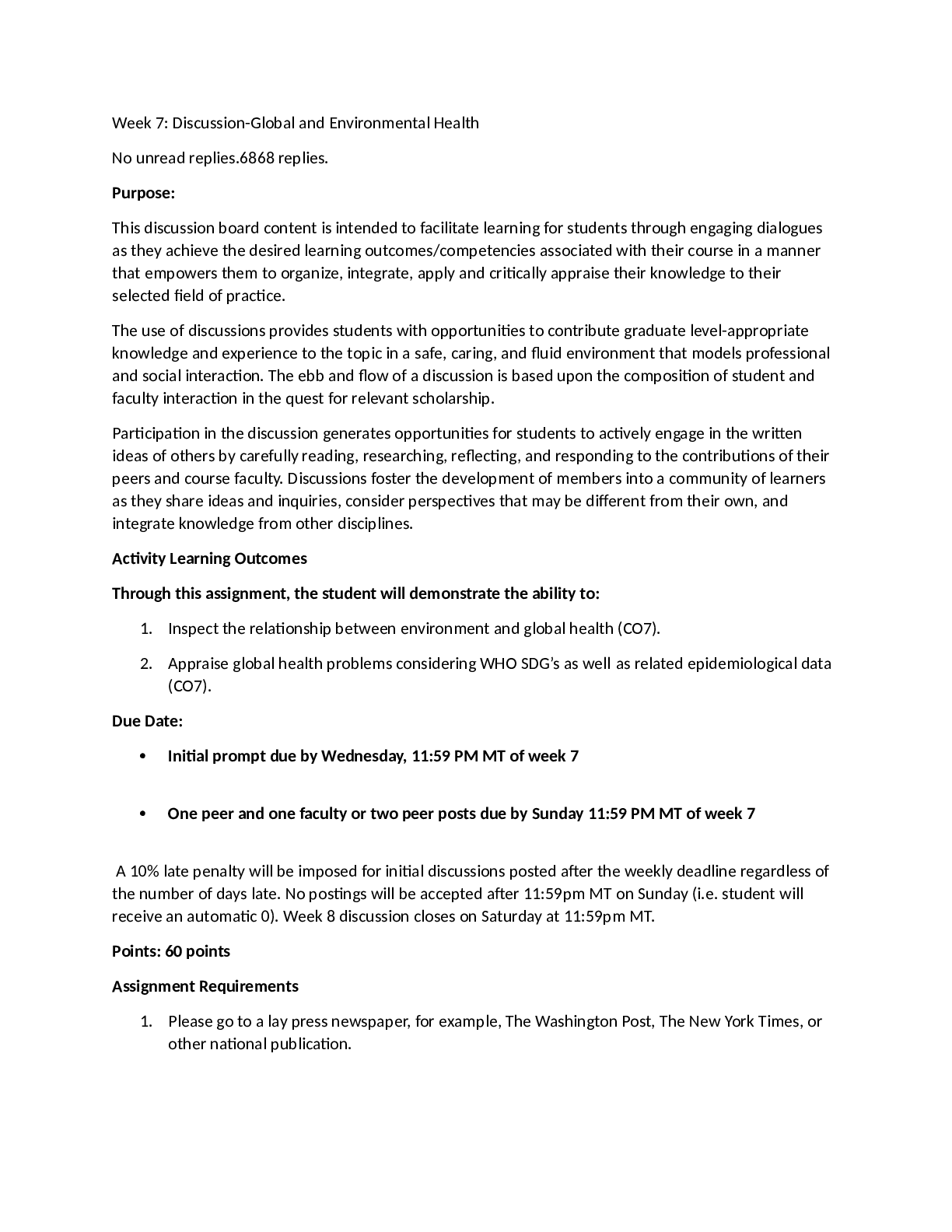


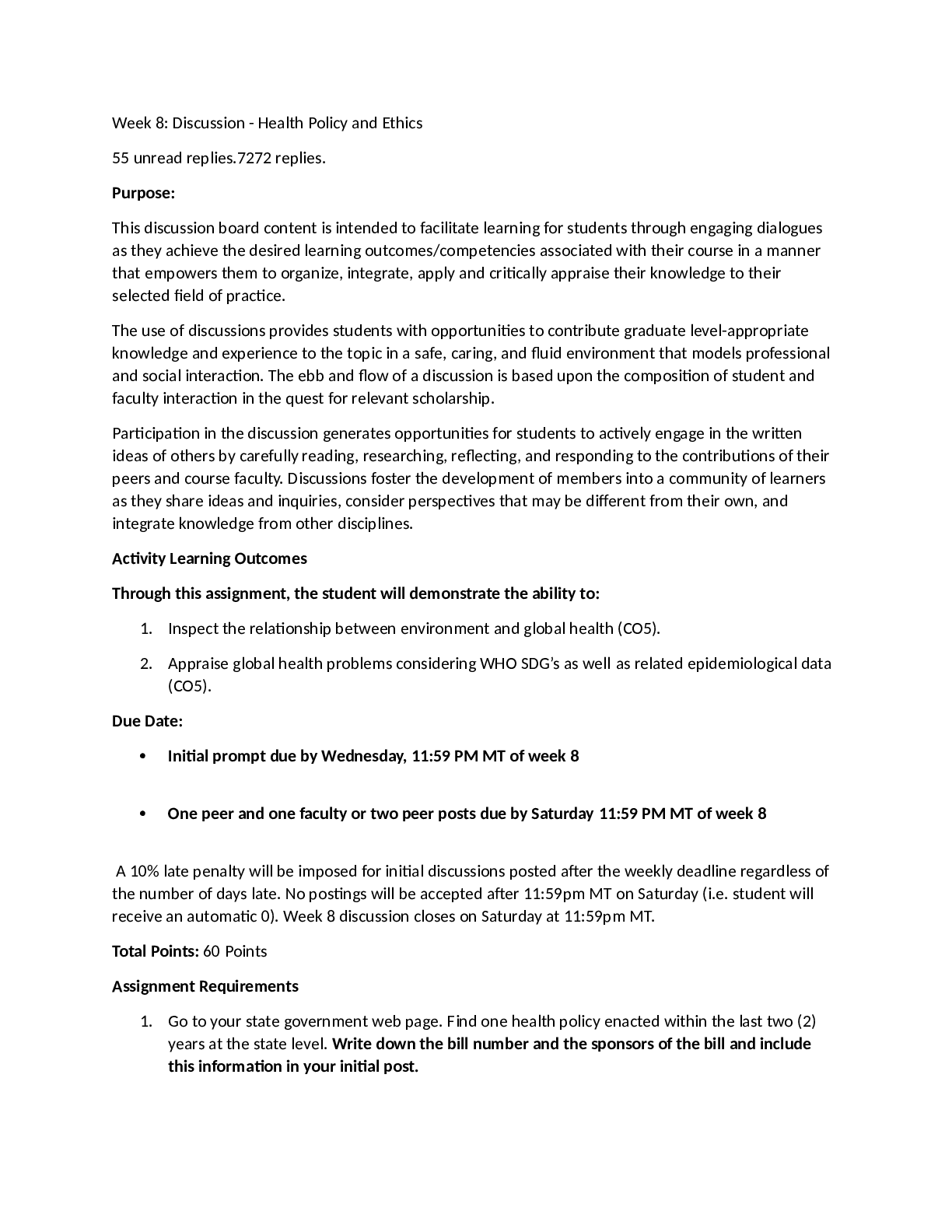

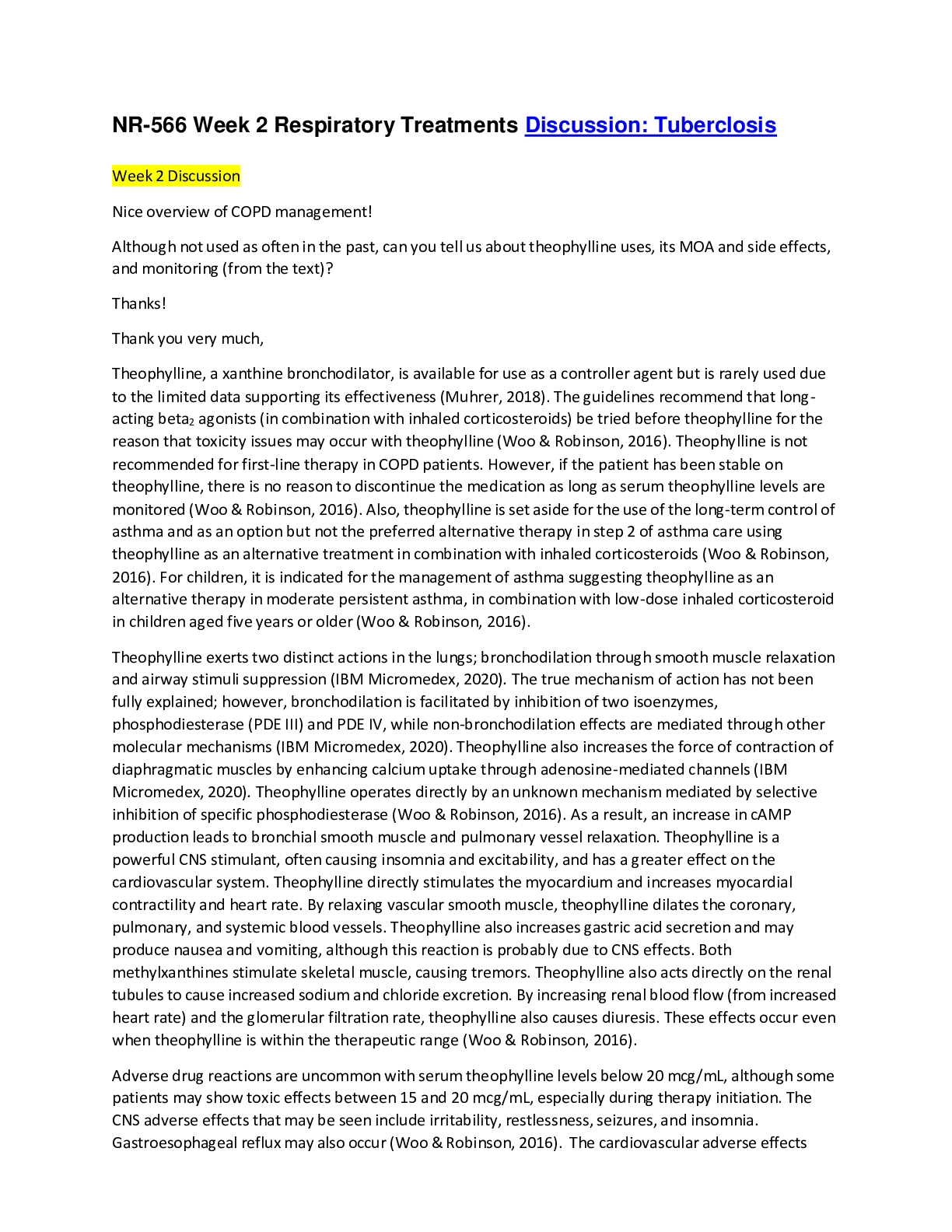
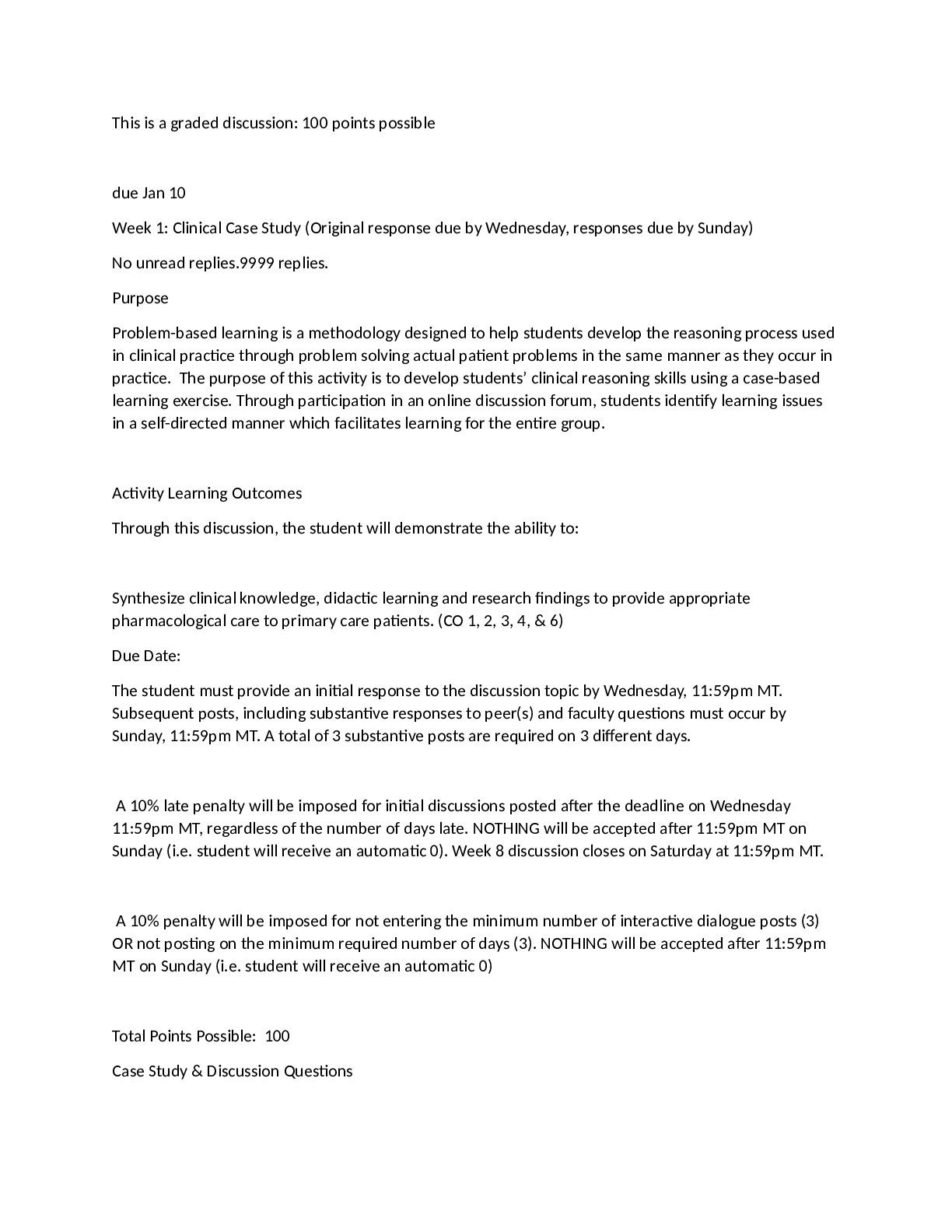
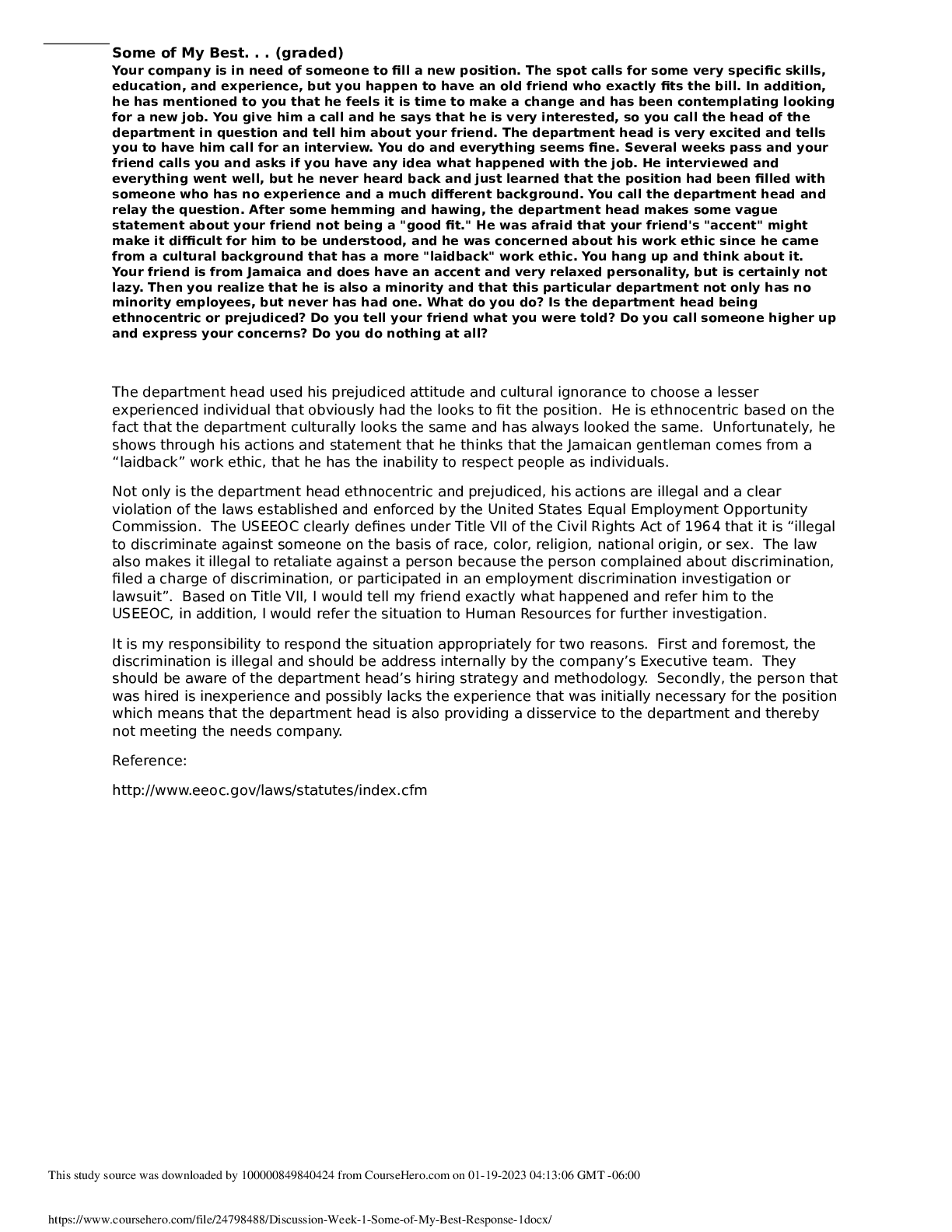


.png)
